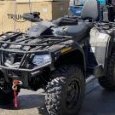2006 trx350te Honda rancher 350 es clutch plates
-
Similar Forum Topics
-
By skittle021
So I've got a Hisun 550 that I was doing some work on that required removing the CVT and it's housing. Upon attempting to reinstall the clutch, sheaves, etc, I found that the belt no longer fits - it's far too wide. None of the parts have been replaced, they're all OEM. Exactly the same parts as what I took off a few weeks ago.
To be more specific, my belt is 1.25in wide, but the gap between the clutch and the primary sheave is only 7/8in wide. I'll include a few photos to explain.
Has anyone ever experienced such a bizarre problem? Any help at all would be appreciated, I've been stuck on this for a month. I'm open to just about any suggestion.
Photos:
-
By Suzukiquad
If you had to choose one mod that you couldn't live without, or had to recommend one what would it be?
-
By Sofaspud
My 2008 can-am Outlander 800r is having hard shifting issues. Does anyone have a fix for this ?
-
By Am2007
Hi everyone,
Outlander 2006 400 XT i have replace the startor cover and right after i did that the oil light is on and not turn off, i check the wires and checked the oil level, everything seem to be normal quad is starting without any problem and rev just fine. i did not want to ride it since im not sure if it is faulty sensor or not so just be safe i did not let it run more the a minute or so.
I have read in the owner manual that i need to clean the oil strainer every 200hr unfortunately i never did that, my service manual that i have does not even indicate of such a thing. so i did some search around and it seem like canam split the manual into 3 parts
owner manual
service manual
engine manual
I have the first 2 but i can not find the last one, part number 219100232. If someone can guide me where do i find the oil strainer so i can clean it i will appreciate it. im going to do an oil pressure test tomorrow to check how many PSI i have, just to make sure.
Thanks

-
By p5200
Hello folks, my machine wound up with I think water in the tank etc. It runs but speeds up and slows back down randomly. When not running I don't see gas dripping from the drain nipple on bottom of float bowl and drain screw is closed tight. With normal idle speed I see no leaking. When the idle speed increases quite a bit on it's own, gas appears to start slowly dripping from float bowl drain nipple? I'm wondering if the carb is flooding and the gas is actually coming from higher up and just appears, to be coming out of nipple but, is actually running down the sides of the nipple? I put a kit in the factory Mikuni carb last year after sitting for a while and I think the gas in the jug I used had drawn moisture. I plan to pull the carb tomorrow and clean everything out. I was just curious if anyone else thinks it's probably something in the carb and is, acutally a flooding problem? Thanks Folks! 🙂
-







Recommended Posts
Join the conversation
You can post now and register later. If you have an account, sign in now to post with your account.
Note: Your post will require moderator approval before it will be visible.